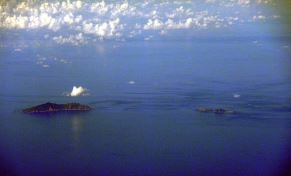(Photo Credit: Japanese Wikipedia)
(BGF) – In an Op-Ed published in the Moscow Times on December 3, 2013 Joseph Nye, University Distinguished Service Professor at Harvard’s Kennedy School of Government and a member of the Boston Global Forum’s Board of Thinkers, discussed Japan’s recent economic recovery in the wake of the earthquake, tsunami, and nuclear catastrophe in 2011. As Nye notes in the article, Japan’s recent economic growth is subject to several long-term challenges. Among those challenges, Nye lists Japan’s aging and shrinking population, its historically tense relationship with its neighbors which has lingered since World War II, and the recent territorial dispute with China in the East China Sea. Ultimately, Nye makes several recommendations that will allow Japan to look to the future and reinforce its soft power. The full article can be found on the Belfer Center for Science and International Affairs’ website: http://belfercenter.ksg.harvard.edu/publication/23707/return_of_japan_after_20_years_of_stagnation.html?breadcrumb=/experts/3/joseph_s_nye
The Return of Japan After 20 Years of Stagnation
By Joseph S. Nye
“Japan is back!” Prime Minister Shinzo Abe declared during a visit to Washington earlier this year. But while Japan may be on the right track after two decades of economic stagnation, there is still much to be done to secure the country’s long-term future.
In July, Abe’s Liberal Democratic Party won control of both houses of parliament, a resounding electoral victory that amounts to the strongest political mandate any Japanese leader has received in many years. As a result, Abe seems likely to remain in power longer than his ineffectual predecessors, most of whom did not last more than a year.
Meanwhile, Japan’s economy seems to be recovering from a generation of malaise, with this year’s annualized growth rate exceeding 3 percent. Moreover, following the triple shock of the earthquake, tsunami and nuclear catastrophe in 2011, Japan has managed, at considerable cost, to replace the 25 percent of its energy supply that the disabled reactors at the Fukushima Daiichi plant provided. The announcement that Tokyo will host the 2020 Olympic Games has also boosted public confidence.
Skeptics worry that the economic progress may not last, arguing that the high growth rate is simply a reflection of loose monetary policy and fiscal stimulus, a strategy that inflation will render unsustainable. Abe’s supporters reply that the third “arrow” of “Abenomics” — productivity-enhancing structural reforms — has only now been removed from its quiver. They point to Abe’s ability to overcome resistance from small rice farmers, part of the Liberal Democratic Party’s electoral base, to Japan’s participation in negotiations on the Trans-Pacific Partnership, which would open Japan’s economy to increased global competition.
Nevertheless, Japan faces serious long-term challenges. First, with its birth rate well below replacement level, Japan’s population is aging and shrinking. Offsetting this trend will require increased immigration and greater female labor-force participation, neither of which will be easy to bring about. Japan has not traditionally been a country of immigration, and the World Economic Forum’s Global Gender Gap Report, which ranks 136 countries, has Japan in 105th place. But of course, this can change, and Japan does have a history of successfully reinventing itself.
Perhaps the most critical question about Japan’s future concerns its relationship with its neighbors: North Korea, South Korea and China. While recent polls suggest that Japan retains substantial soft power globally, this is not the case in its immediate neighborhood.
Unlike Europe, where Germany overcame World War II’s legacy through its integration into the European Union, Northeast Asia remains burdened by history. According to its neighbors, Japan’s apologies for is past aggression are inadequate. It does not help that some South Korean and Chinese leaders have used anti-Japanese rhetoric to win domestic support.
In Japan, the relentless criticism has triggered a nationalist backlash, spurring politicians to respond in kind during last year’s election campaign. For example, Abe threatened to rescind the official apologies issued by former leaders or officials for abuses and atrocities committed by Japan’s army during World War II and stated his intention to visit the controversial Yasukuni Shrine, which honors not only Japan’s war dead but also many of its war criminals. While Abe has not acted on these campaign statements, some observers remain convinced that he will visit Yasukuni at some point, further straining Japan’s relations with South Korea and China.
Territorial disputes have exacerbated these tensions significantly. China challenges Japanese control [of] more than seven square kilometers of islets — called the Senkaku Islands in Japan and the Diaoyu Islands in China — in the East China Sea. While the rival claims date back to the late 19th century, the latest flare-up, which has included widespread anti-Japanese demonstrations in China, was triggered in September 2012, when Japan’s government purchased three of the tiny islets from their private Japanese owner.
Then-Prime Minister Yoshihiko Noda said he decided to purchase the islands for the Japanese central government to prevent Tokyo Governor Shintaro Ishihara from purchasing them with municipal funds. Noda feared that Ishihara, who was well known for nationalist grandstanding, would try to occupy the islands or find other ways to use them to provoke China.
But Chinese officials viewed the move as proof that Japan was trying to disrupt the status quo. Some even claimed that Japan was trying to reverse the territorial outcome of World War II.
The full article can be found at: http://belfercenter.ksg.harvard.edu/publication/23707/return_of_japan_after_20_years_of_stagnation.html?breadcrumb=/experts/3/joseph_s_nye
